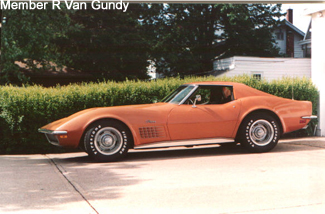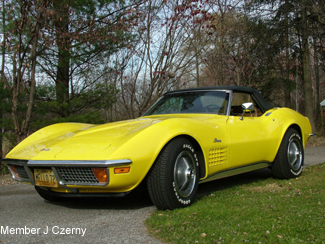
The 1972 Corvette Stingray was basically the same as the 1971 model. Sport Coupe and Convertible Coupe body styles were offered. Some enthusiasts call the ragtop a roadster, but it had a fixed windshield and roll-up windows, which qualified it as a true convertible. The Sport Coupe, by the way, was technically a two-door hardtop.
As usual, the Sport Coupe was the more expensive, more popular model. Corvette drivers liked the convenience of a closed car. Maybe that's one reason why America's favorite sports car survived when lower-rung British sports cars started to disappear. People were willing to pay more for what they wanted and the $5,533 window sticker on the Vette hardtop model did little to scare them away. The Sport Coupe accounted for 20,496 deliveries during the '72 model year.
While most automakers charge extra for their convertibles, Chevy did not in the case of the Corvette - at least not in 1972. Priced at $5,296, the open car matched the hardtop in weight at 3,215 pounds, but it had much lower production total, with just 6,508 units leaving the assembly line. An auxiliary hardtop was optional for the convertible at $273.85. Buyers could also add a vinyl covering to the auxiliary hardtop for $158 extra. None of this made the car go faster, but it may have made the owner's heart beat faster.
Among the Corvette's standard equipment in 1972 was a positraction rear axle; a left-hand outside rearview mirror; all tinted glass, a flo-thru ventilation system; front and rear disc brakes, an electric clock, floor carpeting, wheel trim rings, all-vinyl upholstery and an anti-theft alarm system.
Buyers had their choice of 10 exterior colors: Sunflower Yellow, Pewter Silver, Bryar Blue, Elkhart Green, Classic White, Mille Miglia Red, Targa Blue, Ontario Orange, Steel Cities Gray and War Bonnet Yellow. All convertibles came with a choice of Black or White soft tops. Interior colors options were: Black, Blue, Red and Saddle Tan.
For matching-number lovers, the VIN is stamped on a plate on the inner vertical surface of the left windshield pillar. The numbers for convertibles are 1Z67K2S500001 to 1Z67K2S527004 and for Sport Coupes 1Z37K2S500001 to 1Z37K2S527004. The first symbol 1 indicates the manufacturer, Chevrolet. The second symbol identifies the body series, Z for Corvette. The third and fourth symbols indicate the body style number. In GM nomenclature, 67 means a convertible and 37 means a two-door hardtop or Sport Coupe. The fifth symbol is the engine designator: The sixth symbol indicates the model year and is a 2 for 1972. The seventh symbol identifies the assembly plant. All Vettes were made at the St. Louis plant (code S). The last six symbols indicate the sequential production number.
Most 1972 Corvettes used one of two engines. The base ZQ3 V-8. was a 350 with an 8.5:1 compression ratio and a Rochester Quadra-Jet carburetor. It provided 250 hp at 4400 rpm and 300 lbs.-ft. of torque at 2800 rpm. Typically, a Corvette with this engine could do 0-to-30 mph in 3.1 seconds, 0-60 mph in 8.5 seconds and the quarter mile in 15.2 seconds at 83 mph. It provided five-main-bearings reliability, but it wasn't a high-performance mill by any means.
Those who wanted to go faster without going wild opted for the LS5 454, which added a high-performance hydraulic-lifter camshaft. It was good for 270 hp at 4000 rpm and 390 lbs.-ft. of torque at 4000 rpm. A Rochester 750-cfm Quadra-Jet was fitted to this engine. An LS5 Vette could do 0-to-30 mph in 3.8 seconds and 0-60 mph in 6.8 seconds. It covered the quarter mile in 14.1 seconds at 93 mph. The gain in performance cost Corvette buyers $294.90.
There were other options for '72 Corvettes. The LT1 was relatively rare and the ZR1 was nearly as rare as they come. The LT1 V-8 was a high-performance 350-cid small-block. It used a 9.0:1 compression ratio and a Holley four-barrel to churn up 255 hp at 5600 rpm and 280 lbs.-ft. of torque at 4000 rpm. Other LT1 goodies included a forged steel crankshaft, solid valve lifters, a high-performance camshaft, an aluminum intake manifold and a 2.50-inch diameter dual exhaust system. Cars equipped with the ZL1 had a special hood.
Only 1,336 cars got the $483 LT1 option. In addition, 20 very special ZR1 Corvettes ($1,010 extra) also carried the LT1 engine. Motor Trend magazine tested a 1972 LT1 coupe with the M21 transmission and 3.70:1 axle in June 1972. The car did 0-to-30 mph in 2.9 seconds, 0-to-45 mph in 4.8 seconds, 0-to-60 mph in 6.9 seconds, 0-to-75 mph in 10.2 seconds and the quarter mile in 14.3 seconds at 92 mph.
A Turbo Hydra-Matic automatic transmission with floor-mounted gear shifter was standard Corvette equipment. A close-ratio four-speed with floor-mounted gear shifter was a no cost option. Chassis specifications included a 98-inch wheelbase, an overall length of 182.5 inches and F70-15 tires. The standard rear axle ratio was 3.36:1. Available rear axle gear ratios included 3.70:1, 3.08:1, 3.36:1, 3.55:1 and 4.11:1.
1972 Options
| RPO |
Item |
Price |
| |
Custom Interior Trim |
$158.00 |
| A31 |
Electric Power Windows |
$85.35 |
| A85 |
Custom Shoulder Belts |
$26.35 |
| C07 |
Auxillary Hardtop For Convertible |
$273.85 |
| C08 |
Vinyl Roof Covering For Auxillary Hardtop |
$158.00 |
| C50 |
Rear Window Defroster |
$42.15 |
| C60 |
Air Conditioning |
$464.50 |
| G81 |
Positraction Rear Axle, All Ratios |
$12.65 |
| J50 |
Power Brakes |
$47.40 |
| LS5 |
454-cid 270-hp V-8 |
$294.90 |
| LT1 |
350-cid 255-hp V-8 |
$483.45 |
| ZR1 |
350-cid 255-hp V-8 |
$1010.05 |
| M21 |
Four-Speed Close-Ratio Manual Transmission |
no cost option |
| M40 |
Turbo Hydra-Matic Automatic Transmission |
no cost option |
| N37 |
Tilt-Telescopic Steering Wheel |
$85.30 |
| N40 |
Power Steering |
$115.90 |
| P02 |
Custom Wheel Covers |
$63.20 |
| PT7 |
White Stripe Nylon Tires F70 x 15 |
$30.35 |
| PU9 |
F70 x 15 Raised-White-Letter Tires |
$43.65 |
| T60 |
Heavy-Duty Battery |
$15.80 |
| U69 |
Am-FM Radio |
$178.00 |
| U79 |
Stereo Radio |
$283.35 |